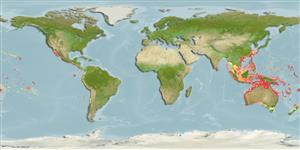>
Mulliformes (Goatfishes) >
Mullidae (Goatfishes)
Etymology: Parupeneus: Latin, parum, parvum = small + Peneus, the name of a river.
More on author: Bleeker.
Environment: milieu / climate zone / depth range / distribution range
पारिस्थितिकी
समुद्री; खारा प्रवाल-भित्ति संयुक्त; गहराई सीमा 10 - 80 m (Ref. 90102). Tropical; 30°N - 50°S
Western Pacific: Japan to Western Australia, New Caledonia and northern New Zealand. Recently reported from Tonga (Ref. 53797).
आकार / वज़न / Age
Maturity: Lm ? range ? - ? cm
Max length : 50.0 cm TL पुल्लिंग / अलिंग; (Ref. 9002)
पृष्ठीय रीढ़ (सम्पूर्ण): 8; पृष्ठीय सौफट रेज़ (सम्पूर्ण): 9; गुदा कांटा 1; ऐनल सौफट रेज़: 7.
Inhabits coastal reefs and estuaries (Ref. 9002); in Indonesia mainly found on deep reefs adjacent to strong currents (Ref. 90102). Juveniles found in small schools; adults singly or in small aggregations (Ref. 9002, 48636). May also be solitary. It is rare in the East Indian region, and found only in cool areas of upwelling; but is common in subtropical latitudes (Ref. 90102).
Life cycle and mating behavior
परिपक्व अवधि | पुनरुत्पत्ति | मछलीऔ का अंडे देना | अंडे | Fecundity | लार्वा
Randall, J.E., G.R. Allen and R.C. Steene, 1990. Fishes of the Great Barrier Reef and Coral Sea. University of Hawaii Press, Honolulu, Hawaii. 506 p. (Ref. 2334)
IUCN Red List Status (Ref. 130435)
Threat to humans
Harmless
Human uses
मात्स्यिकी: व्यापारिक
अधिक जानकारी
आम नामउपशब्दचपायचयपरभक्षीईकोटोकसीकोलौजीपुनरुत्पत्तिपरिपक्व अवधिमछलीऔ का अंडे देनाSpawning aggregationFecundityअंडेEgg development
संदर्भजलीयकृषिजलीयकृषि रूपरेखाखींचआनुवंशिकीElectrophoresesहैरेटिबिलटीबीमारीप्रक्रमणNutrientsMass conversion
सहयोगीयोतस्वीरेStamps, Coins Misc.ध्वनिसिगुयटिरारफ्तारतैरने के प्रकारगिल क्षेत्रOtolithsदिमागदृष्टि
साधन
Special reports
Download XML
इंटरनेट स्रोत
Estimates based on models
Preferred temperature (Ref.
123201): 18 - 28.7, mean 27.2 °C (based on 446 cells).
Phylogenetic diversity index (Ref.
82804): PD
50 = 0.5000 [Uniqueness, from 0.5 = low to 2.0 = high].
Bayesian length-weight: a=0.01259 (0.00753 - 0.02106), b=3.04 (2.90 - 3.18), in cm total length, based on LWR estimates for this species & Genus-body shape (Ref.
93245).
Trophic level (Ref.
69278): 3.5 ±0.2 se; based on diet studies.
लौटाव (Ref.
120179): माध्यम, न्यूनतम जनसंख्या दुगनी होने का समय 1.4 - 4.4 वर्ष। (Preliminary K or Fecundity.).
Fishing Vulnerability (Ref.
59153): Moderate vulnerability (40 of 100).
Nutrients (Ref.
124155): Calcium = 25.9 [12.6, 57.8] mg/100g; Iron = 0.268 [0.134, 0.621] mg/100g; Protein = 18.1 [14.8, 21.2] %; Omega3 = 0.13 [0.07, 0.25] g/100g; Selenium = 55.7 [26.1, 153.8] μg/100g; VitaminA = 164 [29, 748] μg/100g; Zinc = 0.573 [0.339, 1.075] mg/100g (wet weight);
